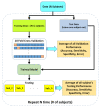Experimental Exploration of Multilevel Human Pain Assessment Using Blood Volume Pulse (BVP) Signals
- PMID: 37112321
- PMCID: PMC10143826
- DOI: 10.3390/s23083980
Experimental Exploration of Multilevel Human Pain Assessment Using Blood Volume Pulse (BVP) Signals
Abstract
Critically ill patients often lack cognitive or communicative functions, making it challenging to assess their pain levels using self-reporting mechanisms. There is an urgent need for an accurate system that can assess pain levels without relying on patient-reported information. Blood volume pulse (BVP) is a relatively unexplored physiological measure with the potential to assess pain levels. This study aims to develop an accurate pain intensity classification system based on BVP signals through comprehensive experimental analysis. Twenty-two healthy subjects participated in the study, in which we analyzed the classification performance of BVP signals for various pain intensities using time, frequency, and morphological features through fourteen different machine learning classifiers. Three experiments were conducted using leave-one-subject-out cross-validation to better examine the hidden signatures of BVP signals for pain level classification. The results of the experiments showed that BVP signals combined with machine learning can provide an objective and quantitative evaluation of pain levels in clinical settings. Specifically, no pain and high pain BVP signals were classified with 96.6% accuracy, 100% sensitivity, and 91.6% specificity using a combination of time, frequency, and morphological features with artificial neural networks (ANNs). The classification of no pain and low pain BVP signals yielded 83.3% accuracy using a combination of time and morphological features with the AdaBoost classifier. Finally, the multi-class experiment, which classified no pain, low pain, and high pain, achieved 69% overall accuracy using a combination of time and morphological features with ANN. In conclusion, the experimental results suggest that BVP signals combined with machine learning can offer an objective and reliable assessment of pain levels in clinical settings.
Keywords: PPG; blood volume pulse (BVP); feature extraction; machine learning; pain classification; pain intensity classification.
Conflict of interest statement
The authors declare that they have no known competing financial interest or personal relationships that could have appeared to influence the work reported in this paper.
Figures











Similar articles
-
Physiological Sensor Modality Sensitivity Test for Pain Intensity Classification in Quantitative Sensory Testing.Sensors (Basel). 2025 Mar 26;25(7):2086. doi: 10.3390/s25072086. Sensors (Basel). 2025. PMID: 40218599 Free PMC article.
-
Human Activity Recognition Algorithm with Physiological and Inertial Signals Fusion: Photoplethysmography, Electrodermal Activity, and Accelerometry.Sensors (Basel). 2024 May 9;24(10):3005. doi: 10.3390/s24103005. Sensors (Basel). 2024. PMID: 38793858 Free PMC article.
-
Physiological Signal-Based Method for Measurement of Pain Intensity.Front Neurosci. 2017 May 26;11:279. doi: 10.3389/fnins.2017.00279. eCollection 2017. Front Neurosci. 2017. PMID: 28603478 Free PMC article.
-
Automated Emotion Recognition System Using Blood Volume Pulse and XGBoost Learning.Stud Health Technol Inform. 2023 Jun 29;305:52-55. doi: 10.3233/SHTI230422. Stud Health Technol Inform. 2023. PMID: 37386956
-
DeepFHR: intelligent prediction of fetal Acidemia using fetal heart rate signals based on convolutional neural network.BMC Med Inform Decis Mak. 2019 Dec 30;19(1):286. doi: 10.1186/s12911-019-1007-5. BMC Med Inform Decis Mak. 2019. PMID: 31888592 Free PMC article. Review.
Cited by
-
Multilevel Pain Assessment with Functional Near-Infrared Spectroscopy: Evaluating ΔHBO2 and ΔHHB Measures for Comprehensive Analysis.Sensors (Basel). 2024 Jan 11;24(2):0. doi: 10.3390/s24020458. Sensors (Basel). 2024. PMID: 38257551 Free PMC article.
-
Advances in Wearable Photoplethysmography Applications in Health Monitoring.Sensors (Basel). 2023 Aug 10;23(16):7064. doi: 10.3390/s23167064. Sensors (Basel). 2023. PMID: 37631601 Free PMC article.
-
Classifying social and physical pain from multimodal physiological signals using machine learning.Sci Rep. 2025 Jul 29;15(1):27674. doi: 10.1038/s41598-025-12476-8. Sci Rep. 2025. PMID: 40731063 Free PMC article.
-
Physiological Sensor Modality Sensitivity Test for Pain Intensity Classification in Quantitative Sensory Testing.Sensors (Basel). 2025 Mar 26;25(7):2086. doi: 10.3390/s25072086. Sensors (Basel). 2025. PMID: 40218599 Free PMC article.
References
-
- Jain K.K., Jain K.K. The Handbook of Biomarkers. Springer; Berlin/Heidelberg, Germany: 2010.
-
- Marieb E.N., Hoehn K. Human Anatomy & Physiology. Pearson Education; Upper Saddle River, NJ, USA: 2007.
MeSH terms
LinkOut - more resources
Full Text Sources

